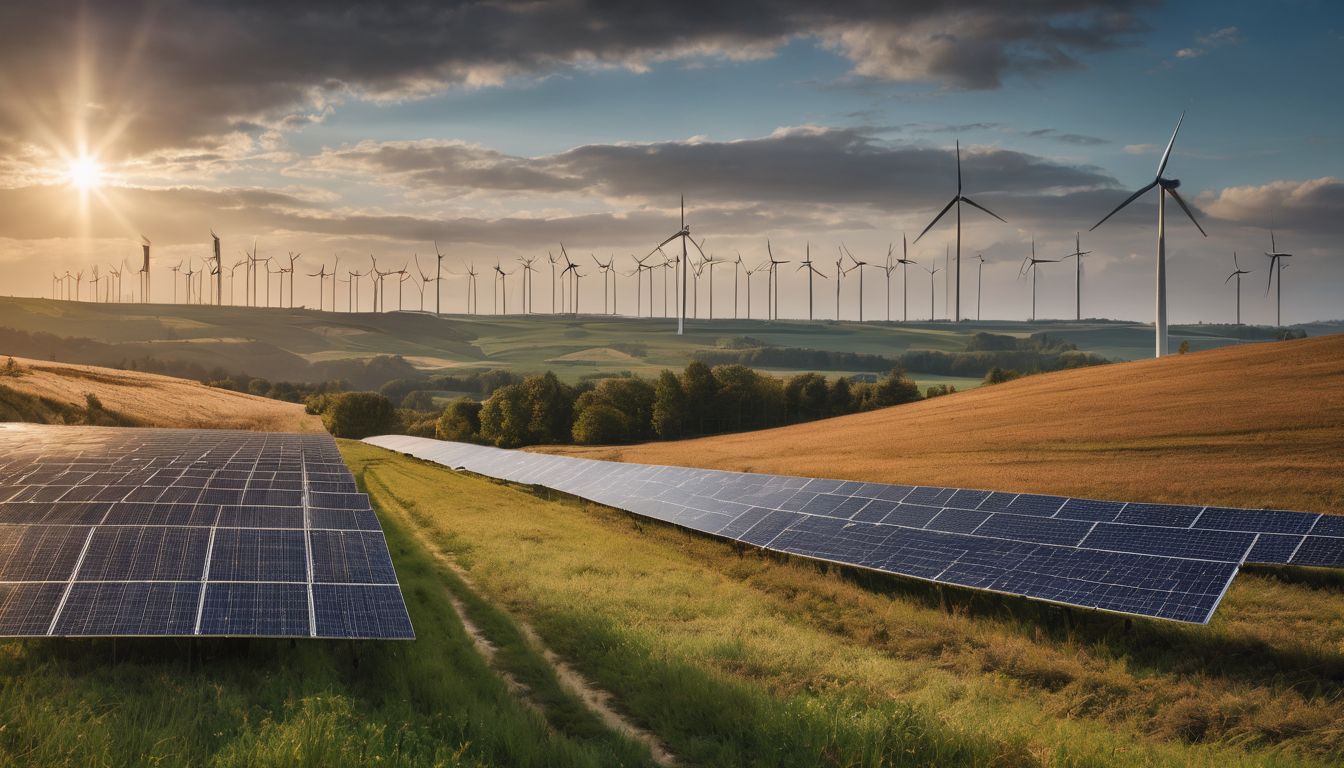Are you feeling the pinch from your rising energy bills each month? Households account for around 29% of total energy use, impacting both our wallets and the planet. Our no-nonsense guide is packed with practical tips to slash those bills and put you at the frontline of eco-defence.
Dive in for savvy secrets to a greener home!
Key Takeaways
- Install LED lighting and unplug electronics when not in use to reduce household energy consumption efficiently.
- Choose appliances with high – energy efficiency ratings, like those with the Energy Star label, which cut down on energy use and help the environment.
- Seal drafts around windows and doors to enhance home insulation, contributing to lower energy bills while preventing unnecessary heat loss.
- Adopt simple habits such as using natural light instead of electric lights during the day and turning off devices completely rather than leaving them on standby mode.
- Consider incorporating renewable energy options like solar panels or wind turbines into your home’s power plan for a sustainable source of electricity.
Understanding Household Energy Consumption
Household energy consumption comes from common sources like lighting, electronics, heating and cooling systems. It’s important to understand the impact of this usage on the environment.
Common Sources of Energy Usage
- Heating and Cooling Systems: These account for a significant portion of energy use. To reduce their impact, consider setting programmable thermostats to adjust temperatures when you’re not home.
- Electrical Appliances: Fridges, washers, dryers, and dishwashers consume considerable power. Opt for eco-friendly appliances with good energy ratings to conserve energy.
- Lighting: Traditional incandescent bulbs are inefficient compared to LED lighting. Swapping old bulbs for energy-efficient lighting reduces electricity usage.
- Water Heaters: A substantial amount of energy goes into heating water. Insulating your water heater can help retain heat and cut down on consumption.
- Electronics: Devices left plugged in still draw power. Unplug electronics when they’re not in use or invest in smart power strips.
- Windows and Doors: Poorly insulated or single-glazed windows cause heat loss. Weatherproofing homes keeps the temperature consistent without extra energy expenditure.
- Standby Power Usage: TVs and computers left on standby mode continue to use electricity; turning them off can lead to significant savings over time.
Impact on the Environment
Household energy consumption has a significant impact on the environment, contributing to carbon emissions and resource depletion. By making simple changes such as upgrading to energy-efficient appliances and using natural light, individuals can reduce their carbon footprint and contribute to environmental conservation.
Energy-saving measures not only lead to cost savings but also play a crucial role in promoting sustainable living.
Embracing eco-friendly habits like unplugging electronics when not in use and choosing sustainable technology options align with the principles of environmental stewardship. Optimising heating and cooling systems, conserving water, and investing in renewable energy sources are effective ways for households to support sustainability and reduce their impact on the environment.
Simple Changes for Energy Savings
Upgrade to LED lighting and unplug unused electronics to reduce energy consumption. Utilise natural light and weatherproof your home for added energy efficiency.
Upgrade to LED Lighting
Consider upgrading to LED lighting for a more energy-efficient home. LED bulbs use significantly less energy than traditional incandescent or CFL bulbs, helping to reduce your carbon footprint and lower electricity bills.
By making this simple switch, you can enjoy long-lasting, eco-friendly lighting while contributing to a greener lifestyle.
LED lighting is an easy way to embrace energy efficiency and reduce environmental impact. With the wide availability of LED bulbs in various shapes and sizes, it’s now simpler than ever to transition your household lighting to this eco-friendly option.
Unplug Unused Electronics
When not in use, unplug electronics to avoid standby power consumption. This small change can add up to significant energy savings over time. Chargers, TVs, computers, and other devices continue to draw power even when turned off if they are left plugged in.
By unplugging these items when they’re not being used, you can reduce your energy usage and lower your carbon footprint.
Unplugging unused electronics is an easy way to practice energy conservation at home without sacrificing convenience or comfort. Making this simple adjustment is a step towards embracing an eco-friendly lifestyle and reducing unnecessary energy wastage.
Utilise Natural Light
Take advantage of natural light by opening curtains and blinds during the day to reduce the need for artificial lighting. Position workspaces and seating areas near windows to maximise the use of sunlight.
This not only decreases energy consumption but also creates a more pleasant and inviting indoor environment. Additionally, consider using light-coloured interior decor to reflect natural light further into your living spaces.
By incorporating these simple practices, you can significantly decrease your reliance on electric lights, leading to reduced energy usage and lower utility bills.
Weatherproof Your Home
Seal any drafts around windows and doors to keep heat in and save energy. Adding weather stripping, caulking gaps, and using door sweeps effectively prevents air leaks. Insulating attics, walls, and floors can make a significant impact on maintaining a comfortable temperature in your home while reducing energy consumption.
Weatherproofing not only makes your home more energy-efficient but also contributes to a greener environment by lowering carbon emissions.
Install storm windows and doors to further enhance the insulation of your home. Consider upgrading to double- or triple-pane windows that have low-emissivity coatings for increased thermal efficiency.
Energy-Efficient Appliances and Habits
Choose energy-efficient appliances and adopt energy-saving habits to reduce your household’s carbon footprint and save on utility bills. Read on for more tips on how to make your home eco-friendly.
Choosing Energy-Efficient Appliances
When selecting appliances, look for those with high energy efficiency ratings. Opt for appliances with the Energy Star label to ensure lower energy consumption and reduced environmental impact.
- Look for appliances with energy-saving features such as automatic shut-off or power-saving modes. These features can significantly reduce energy usage during periods of inactivity.
- Consider the size of the appliance in relation to your household needs; larger appliances may consume more energy than necessary.
- Opt for multi – functional appliances that combine several functions into one unit, reducing the need for multiple devices and saving both energy and space.
- Look for appliances with modern technology, including improved insulation and advanced components that increase energy efficiency.
- Review the product manual or manufacturer’s specifications to determine the estimated annual energy consumption before making a purchase decision.
- Consider incorporating smart home technology, such as programmable thermostats and remote-controlled appliances, to optimise energy usage based on your daily routine.
Setting Energy-Saving Habits
Transitioning from choosing energy-efficient appliances to setting energy-saving habits is crucial for a truly eco-conscious household. By implementing simple yet effective changes in your daily routine, you can significantly reduce your carbon footprint and contribute to a greener environment.
- Turn off lights and electronics when leaving a room to save energy and lower electricity bills.
- Utilise natural ventilation whenever possible instead of relying on air conditioning, reducing energy consumption.
- Make it a habit to use cold water for washing clothes to conserve hot water and decrease energy usage.
- Unplug chargers and appliances when not in use to prevent unnecessary power drain.
- Set your thermostat a few degrees lower in the winter and higher in the summer to save on heating and cooling costs.
- Incorporate shorter showers into your routine to limit water usage and reduce the demand for hot water.
- Regularly maintain household appliances, ensuring they operate efficiently and consume minimal energy.
Conservation Tips for Water and Heat
Reduce hot water usage by taking shorter showers and using cold water for laundry, insulate your water heater to reduce heat loss, and optimise your heating and cooling systems to conserve energy.
Learn more about these practical tips for saving energy in your home.
Reducing Hot Water Usage
Lower your hot water usage by installing low-flow showerheads and faucet aerators. These simple additions can reduce water usage without sacrificing water pressure, saving both energy and money.
Insulating hot water pipes is another effective way to decrease heat loss, ensuring that the water retains its temperature as it travels through the plumbing system. Additionally, setting the thermostat on your water heater to 120 degrees Fahrenheit will help conserve energy while still providing comfortably warm water for household use.
Conserve further by running full loads in dishwashers and washing machines. Fixing leaks promptly also prevents wastage of both water and energy. Finally, consider using cold or warm settings on your washing machine instead of hot whenever possible—this small change significantly impacts overall energy consumption.
Insulating Water Heater
Insulating your water heater can help reduce heat loss and conserve energy, making it a cost-effective and eco-friendly solution. By adding insulation to the outer surface of your water heater, you can prevent excess heat from escaping, thus reducing the need for frequent reheating.
This simple step aids in maintaining the water temperature for longer periods, resulting in reduced energy consumption and lower utility bills. Consider using an insulating blanket or jacket specifically designed for water heaters to maximise efficiency.
Now let’s explore how to optimise heating and cooling systems for greater energy savings.
Optimise Heating and Cooling
Optimising heating and cooling is vital for energy efficiency in an eco-conscious household. Here are some effective ways to do so:
- Use a programmable thermostat to regulate temperature settings, adjusting them when no one is at home or during sleeping hours.
- Enhance insulation in your home to prevent heat loss, including windows, doors, and attics.
- Regularly maintain heating and cooling systems to ensure they operate efficiently and use less energy.
- During the warmer months, use ceiling fans or natural ventilation instead of relying solely on air conditioning.
- Consider installing energy – efficient windows and shades to reduce heat gain in the summer and heat loss in the winter.
- When heating, keep doors closed to contain warmth within specific areas of the house, reducing the need for overall heating.
Embracing Smart and Sustainable Technology
Make the switch to smart home technology to monitor and control your energy usage more effectively. Consider renewable energy options such as solar panels to reduce your reliance on traditional grid power.
Smart Home Technology
Upgrade to smart home technology for efficient energy management. Control your heating, lighting, and appliances remotely through smart devices. Monitor your energy usage in real-time to make adjustments for eco-friendly living.
Implementing these technologies can significantly reduce your carbon footprint and contribute to a greener lifestyle while embracing the convenience of modern innovation.
Integrate renewable energy sources such as solar panels and wind turbines into your smart home setup. Harness natural resources for sustainable power generation and decrease reliance on traditional electricity grids.
Renewable Energy Options
- Install solar panels on your rooftop to harness clean, renewable energy from the sun.
- Consider investing in a small wind turbine if you live in a windy area, generating sustainable electricity for your home.
- Explore geothermal heating and cooling systems that utilise the Earth’s constant temperature to regulate indoor climate efficiently.
- Utilise biomass energy sources such as wood or organic waste for heating or electricity production, reducing reliance on fossil fuels.
- Harness the power of hydropower by installing a micro-hydroelectric system if you have access to a running water source on your property.
Conclusion
In conclusion, embracing energy-saving tips can make a significant impact on the environment. Upgrading to LED lighting and unplugging unused electronics are simple changes that lead to substantial energy savings.
Choosing energy-efficient appliances and setting energy-saving habits are key steps in adopting a sustainable lifestyle. By incorporating these practices, eco-conscious households can lower their carbon footprint and contribute to a greener future for our planet.
FAQs
1. What are energy-saving tips for an eco-conscious household?
Energy-saving tips include using energy-efficient appliances, switching to eco-friendly cleaning supplies, and optimising natural light in your home to reduce the use of electricity.
2. How can I make my house more energy-efficient?
You can make your house more energy-efficient by installing energy-efficient lighting, conserving water with smart usage practices, and choosing eco-friendly appliances that consume less power.
3. Why should I consider green living?
Green living helps you lead a more sustainable lifestyle which reduces your carbon footprint and contributes positively to the environment.
4. Can eco-friendly cleaning supplies really make a difference?
Yes, using eco-friendly cleaning supplies cuts down on harmful chemicals in your home and supports a healthier planet by reducing pollution.
5. Are there simple ways to conserve water at home?
Simple ways to conserve water include fixing leaks promptly, taking shorter showers, using efficient fixtures like low-flow toilets, and only running dishwashers or washing machines with full loads.





